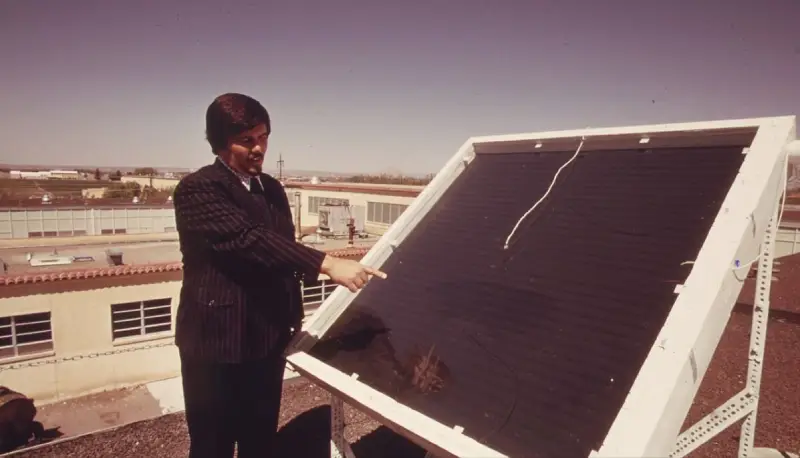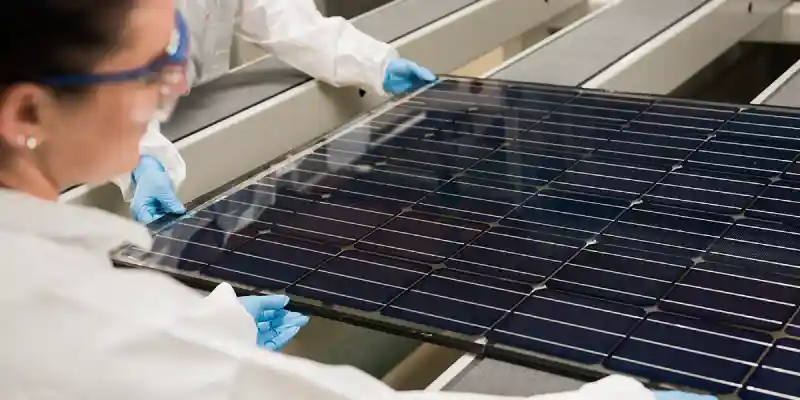Will perovskite spark a solar revolution?
It’s all over the news: solar energy is breaking records left, right, and centre.
Not only are panels cheaper than ever, but their adoption is the fastest among all types of renewable energy.
But what if I told you that we haven’t even seen solar energy shift into fifth gear yet?
Enter Perovskite technology in solar cells to make them cheaper, more efficient, and faster to manufacture.
Shortcuts
- A Brief History of Solar Panels
- What’s wrong with Silicon PV?
- Enter the new era of Perovskite
- What are the Pros and Cons of Perovskite Solar Cells?
- Latest Developments in Perovskite Technology
- Tandem Silicon-Perovskite cells
- So, is perovskite a revolution?
- FAQs
A Brief History of Solar Panels

Before diving into the cutting-edge perovskite cells, let’s do a quick recap of the rapid development of solar cells.
Solar panels were first conceptualised by the renowned scientist Alexandre Becquerel as early as 1839, but the first functional PV solar cell wasn’t produced until 1954 at Bell Labs in the U.S. This silicon-based cell achieved a mere 6% efficiency. A significant breakthrough at the time.
The space-based solar power industry was the first to commercialise solar technology in the late 1950s and 1960s, using it to provide electricity onboard space shuttles and satellites. These early panels were made from high-efficiency but expensive single-crystal silicon.
The 1973 oil crisis sparked widespread interest in renewable energy as a public utility, leading to substantial investment and development in solar power. The first large-scale solar agrivoltaic farm was built in Lugo, California, in 1982, and by the 1990s, solar power had become mainstream in rural properties across Europe and the US.
The financial crisis of 2008 caused a slump in polysilicon prices (from $460 per kg down to $60 per kg) that ignited the solar power boom of the 2010s. Despite a slow global economy, solar PV implementations accelerated during this time, driven by low prices and high demand, as developed countries like China, the U.S., and Europe started decarbonising their energy production.
But despite solar power output surging from 597 GWh in 2005 to 1289 TWh in 2023 (a 200 x increase), solar power still accounts for less than 3% of the global energy mix.
What’s wrong with Silicon PV?
But despite the aforementioned growth, silicon photovoltaics have inherent limitations that are, believe it or not, hampering its growth.
Firstly, manufacturing the main feedstock material, polysilicon, is an energy-intensive metallurgical process that emits much carbon akin to cement-making! Most of this energy is spent removing impurities from the silica.
Secondly, silicon-based PV cells have a theoretical efficiency limit (known as the Shockley-Queisser limit) that confines a single-junction silicon solar cell to a maximum efficiency of around 33%. In contrast, turbine-based renewables (i.e. wind, hydro, geothermal) are hypothetically limited to 99.9%.
Finally, applications are limited by their reduced efficiency at high temperatures (which is why floating solar energy works better), lack of frequency discernment, and high weight, meaning Si-based panels always need strong support. The last two points may not be critical, but research has struggled to overcome these hurdles given the material constraints.
Enter the new era of Perovskite
Perovskites started gaining fame in tech circles in the 1950s when their unique properties were leveraged in fuel cells, glass ceramics, and semiconductors.
Not only do Perovskites have an exceptional ability to absorb light and selectively choose the frequencies to absorb, but their comparatively easy and low-energy production from solutions and their thin and flexible nature makes them an extremely versatile material.
The first perovskite solar cells were produced in the 2000s, with low conversion efficiencies of ~3% achieved in 2006. Fast forward to early 2023, and their efficiencies have already surpassed that of any silicon-based cells, breaking past the 30% efficiency barrier — a tenfold improvement in less than 20 years.
But like everything in life, Perovskite cells also have drawbacks, mostly pertaining to the use of toxic heavy elements in its process and their current lack of durability and robustness compared to silicon PV cells.
We summarise the advantages and disadvantages of silicon and perovskite in the section below!
What are the Pros and Cons of Perovskite Solar Cells?
Advantages of Perovskite Panels
✔️ Can achieve higher efficiencies than silicon panels.
✔️ Production does not require energy-intensive, high-temperature metallurgical processes. It can be produced from simple solutions (or by welding powers using EM-FAST) through chemical reactions.
✔️ Can be made into thinner, flexible cells, as perovskites are 400 times thinner than polysilicon. This enables applications such as photovoltaic glass – a window that generates electricity.
✔️ Works across all visible wavelengths, while silicon panels only absorb low-energy frequencies.
✔️ Can be tuned to absorb only specific wavelengths, enabling specialised techniques in all photonic devices, including solar cells.
✔️ Can be combined with Silicon panels to create hybrid structures like multi-junction tandem solar panels.
✔️ The production is cheaper, faster, and without bottlenecks regarding raw material supply – e.g. Lead and Iodine are widely available elements.
✔️ Life Cycle Assessment (LCA) analyses conclude that Silicon cells have a higher carbon footprint than Perovskite cells.
✔️ Perovskite cell prototypes have passed industry-standard solar panel durability tests (IEC 61215) despite their lesser chemical stability.
Disadvantages of Perovskite Panels
❌ Perovskite panels are less durable: they can’t possibly match the typical 25-year warranty of silicon panels (at least at present).
❌ Oxygen, moisture, and heat reduce efficiency and lifespan, with field trials suggesting that Perovskite panels lose 80% of their generation capacity in one or two years despite passing the IEC 612515 tests (see advantages).
❌ Perovskites contain toxic heavy metals like Lead in their structure, often in a not-so-stable form. This can potentially lead to environmental contamination if not handled properly, so every stage of their lifecycle – from extraction and use to disposal and recycling – needs to be carefully managed to prevent harmful lead exposure.
❌ Other toxic substances like organic solvents, additives and Tin are involved in perovskite cell fabrication.
❌ Perovskite cells are a new technology, with very little real-life data available to judge its actual performance across key metrics, including its durability, which is crucial in determining how cost-effective it is compared to other technologies (LCOE comparisons!)
Latest Developments in Perovskite Technology
Tandem Silicon-Perovskite panels by late 2023
Like silicon cells, Perovskite cells also work using the photovoltaic effect. In other words, light absorption occurs in the semiconductor material, resulting in free electrons that are transferred to an external conductor (a wire), generating helpful electricity.
But despite this similarity, transitioning any technology from prototype into the mainstream in a single move is uncommon. For example, before this first generation of 100% EVs, including Teslas and BYDs, we had a decade of hybrid vehicles like the Toyota Prius flooding the market.
A very similar approach is being taken with perovskite cells: the first commercially available panels will likely be Tandem Silicon-Perovskite panels, which are essentially a hybrid to introduce the new technology into existing, robust designs.
Thanks to financial support from the US government and the EU, these tandem panels could be commercially available as early as Q4 2023, with two companies in Europe, Oxford PV and Voltec, putting the final touches on their first production factories in Germany and France, respectively.
EM-FAST will make production cheaper, better, faster and stronger
Besides the usual substantial leaps in efficiency, a new method of producing perovskite sheets that are cheaper, better, and faster has recently been proven to work.
EM-FAST is a new method for generating perovskite halides (the cell material) by fusing powdered raw materials together instead of producing them from a solution. Not only is none of the raw material wasted (99.9% yields!), but the process can be done in minutes at a fraction of the cost of existing methods.
If this isn’t bullish, we’re not sure what is!
Tandem Silicon-Perovskite cells

Tandem Silicon-Perovskite cells represent an innovative solar technology that pairs the advantages of perovskite without needing to overhaul the established manufacturing of silicon panels or compromise their durability and robustness.
In terms of efficiency, this design capitalises on the strengths of both materials: the perovskite top cell absorbs the high-energy, short-wavelength sunlight, while the silicon bottom cell absorbs the lower-energy, long-wavelength light.
The efficiency of these units is unprecedented, with tests suggesting they already surpass the 30% efficiency barrier.
Multiple companies are venturing into creating this product, the most renowned being the pioneer Oxford PV. Other household names include Voltec, Qcells, ENEL Green Power, and Meyer Burger, among many others.
So, is perovskite a revolution?
There’s little doubt that perovskite technology will significantly improve solar power.
On the one hand, it presents a leap in efficiency, cost reduction and ease of manufacturing to traditional solar panels as we know them. This is already an understated revolution, given the crazy adoption of the vastly inferior Silicon-based cells that are even causing talks of a utilities death spiral.
However, the real revolution of perovskite will come further down the line as they clearly enable currently unimaginable applications. Just off the top of our heads, super cheap photovoltaic windows that produce electricity from the relevant wavelets may already be a game changer for urban in-situ electricity production.
Can you imagine a skyscraper whose lighting systems work solely from a perovskite cell coating on its windows? This may be much closer than we currently imagine…
Perovskite solar cells – FAQs
Here are the most common questions asked surrounding perovskite solar cells.
Is Perovskite the Future?
Perovskite solar cells exist, but as of 2023, they’re primarily utilised in research and pilot projects. Their use in commercial applications is currently limited due to long-term stability and scalability challenges. Nonetheless, the potential they offer keeps them at the forefront of renewable energy research.
Are perovskite solar cells available?
Perovskite solar cells for solar energy generation aren’t commercially available to retail or businesses as of August 2023. However, commercial production is anticipated to commence in late 2023 or early 2024, and there are indeed pilot perovskite projects in operation, as well as other applications of perovskite in technology since the 1950s.
See our Latest Developments section for more details.
Why is perovskite better than silicon?
Perovskite boasts numerous advantages over silicon, including:
- Higher efficiency and enhanced versatility.
- Cheaper, faster, and simpler manufacturing process.
- It can be crafted thinner, which opens more applications.
Please see our Advantages section for more detailed information.
How will perovskite change the future?
Perovskite could significantly change the solar power industry by driving efficiencies, eliminating supply material bottlenecks, and displaying high scalability potential. The challenges are its potential toxicity and durability, but solutions are expected. The near future sees hybrid silicon-perovskite panels as a step towards a perovskite-dominated industry.
What is a perovskite solar cell?
A perovskite solar cell is a type of solar energy technology that utilises a group of minerals called perovskites instead of silicon to capture sunlight and convert it into electricity.
Perovskite excels at absorbing sunlight and carrying the electrons away as useful electricity. It’s also inexpensive and easy to manufacture, particularly with the latest EM-FAST methodology developed in 2023. Moreover, it can readily be made into thin, flexible, lightweight cells that can be utilised for a much wider array of applications than traditional polysilicon solar cells.
However, perovskite solar cells aren’t yet commercially available and must prove their durability. They also need to overcome concerns about the environmental safety of certain materials, such as lead.
What is perovskite technology?
Perovskite technology uses perovskite-structured materials in various applications, notably in solar cells.
Perovskites have unique properties that allow for efficient light absorption, charge separation, and transport, crucial for converting sunlight into electricity. Solar cells are potentially less expensive and more flexible than traditional silicon-based cells, and their efficiency has improved dramatically in recent years.
However, the remaining hurdles include long-term stability under moisture and heat, and the use of environmentally concerning materials across its supply chain.
Beyond solar cells, perovskite technology also has potential in LED lights, lasers, and other photonic (electromagnetic) devices.
What is perovskite made from?
Perovskite is a type of crystal structure made from three types of ions:
- A large organic or inorganic cation,
- A smaller metal cation (often lead or tin) and
- An anion (typically a halogen like iodine, bromine, or chlorine).
These components form a three-dimensional lattice with ideal properties for converting sunlight into electricity.
What is an example of a perovskite solar cell?
An example of a perovskite solar cell is a tandem perovskite-silicon cell, which will be the first commercially available cell when released. It layers a perovskite cell (to absorb high-energy light) with a silicon cell (to capture lower-energy light). This combination results in more efficient solar panels without overhauling the traditional build of single-junction solar cells.
External Resources
- independent.co.uk
- bernreuter.com
- ourworldindata.org
- pv-magazine
- US Department of Energy
- wikipedia.org
- Science Direct
- Undecided with Matt Ferrell – Top 5 Solar Advances
- Undecided with Matt Ferrell – Perovskite Solar Cells
- perovskite-info.com
- commercialsolarguy.com
Extended reading:
Agrivoltaic Solar Farms: Find out what Agrivoltaic solar farms are, what their origins are, what the different types are and much more.
Solar Roof Tiles: Find out all about the new technology of solar roof tiles, what they are, how they work and the pros and cons.
Solar Powered Seawater Greenhouses: Learn all about desert greenhouses, solar desalination and the Sundrop system.
Space-Based Solar Power: Learn all about space-based solar power, who invented it, and the different types of space-based solar.
PV Solar: Read all about what PV solar batteries are, how they fit in, and why they are a game changer.

